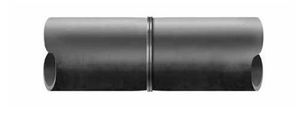Difference between revisions of "Butt fusion (Butt weld)"
| Line 27: | Line 27: | ||
# ISO 21307, Plastics pipes and Fittings – Butt Fusion Jointing Procedures for Polyethylene (PE) Pipe and Fittings Used in Construction of Gas and Water Distributions Systems. | # ISO 21307, Plastics pipes and Fittings – Butt Fusion Jointing Procedures for Polyethylene (PE) Pipe and Fittings Used in Construction of Gas and Water Distributions Systems. | ||
# http://www.pipa.com.au/sites/default/files/document/attachment/pop003.pdf | # http://www.pipa.com.au/sites/default/files/document/attachment/pop003.pdf | ||
| + | # http://www.akatherm.com | ||
Latest revision as of 15:18, 23 March 2017
- Butt welding or Butt fusion is a joint method used for polyethylene (PE) pipes and fittings.
- Butt welding involves the heating of two pipe ends to fusion temperature and then subsequently joining the two ends by the application of force. However, a successful butt weld requires the correct combination and sequence of the welding parameters time, temperature and pressure.
Below are the 3 distinct fusion methods for pipe and fittings with a wall thickness up to and including 70mm; (It is essential that the parameters specified for a given method are followed. Do not mix and match parameters from each method.) The choice for one of these three procedures depends on local experience and availability of equipment.
- Single pressure – low fusion jointing pressure
This method has been used by most European countries and in Australia.
- Dual pressure – low fusion jointing pressure
This method is used by the water industry in the UK, and in Europe for pipe with a wall thickness greater than 20mm. These parameters are not commonly used in Australia.
- Single pressure – high fusion jointing pressure
This method has been used extensively in North America. The weld interface pressure is approximately three times the low pressure method and as a consequence, more of the molten material is extruded from the weld zone, thereby enabling a reduced cooling time. Extra attention is required to ensure that;
- Welding machines have sufficient structural strength and hydraulic capacity to achieve the high pressure parameters in a safe manner. Confirmation should be sought from the machinery manufacturer.
- The welding operator is sufficiently experienced and proficient with the parameters.
Where the pipe or fitting wall thickness exceeds 70mm –welding parameters should be agreed between the asset owner and the installer. Under these circumstances the pipe and fitting supplier and the equipment supplier should also consulted.
ISO 21307 specifies three proven butt fusion jointing procedures for pipes and fitting with a wall thickness up to and including 70mm, taking into consideration the materials and components used, the fusion jointing procedure and equipment and the quality assessment of the completed joint.
References
- ISO 21307, Plastics pipes and Fittings – Butt Fusion Jointing Procedures for Polyethylene (PE) Pipe and Fittings Used in Construction of Gas and Water Distributions Systems.
- http://www.pipa.com.au/sites/default/files/document/attachment/pop003.pdf
- http://www.akatherm.com

